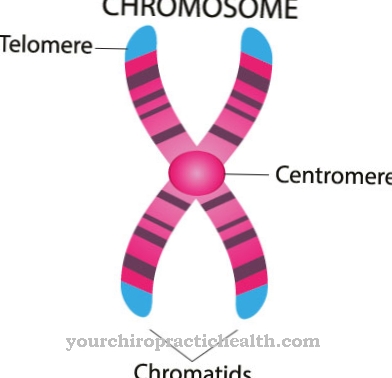Of the Megalomania (also as megalomania describes an overestimated self-esteem to an extreme degree. This concerns, for example, the delusional idea of being an important person or figure (with a mission).The megalomania often occurs as a symptom of mental disorders from the circle of narcissistic or schizophrenic personality disorders.
What is megalomania?

© pixelschoen - stock.adobe.com
Megalomania is a form of delusion and is therefore accompanied by the fact that those affected lose a connection with reality. They are not aware of the absurdity between their own experience and evaluation of the situation and reality, while at the same time no perception error is realized by the person concerned (ego syntony).
Megalomania is only a subspecies of madness and can be further differentiated. Often it is a symptom of a narcissistic personality disorder, schizophrenia or manic depression during times of mania.
Even the proof that the content of the delusion is a misperception will not change anything in the subjective convictions of those affected. The megalomania is so pronounced that those affected consider themselves a religious or political figure. Perhaps you can also be a great inventor or be destined to redeem humanity. Accordingly, megalomania can take very different forms and ranges from excessive overestimation of oneself to a willingness to be martyred.
For historical reasons, a distinction must also be made from the Caesarist delusion: This denotes the belief in one's own infallibility and the greed for the universal meaning of many leaders in monarchist or absolutist systems.
However, it is unclear here to what extent the psychological suffering itself is meant and to what extent the description of the historical figures is due to the personality cult and contemporary perspective. Correspondingly, in the case of delusion in the sense of an illness, the Caesarean delusion is excluded, although this is also referred to in common parlance as megalomania.
causes
The megalomania in its origins can best be explained like a mania. But here too, many triggers are considered unexplained. What is certain is that manias of all kinds are often associated with depression (and a corresponding imbalance in the hormonal balance).
The megalomania is always accompanied by an enormous feeling of elation, which speaks for a disruption in the messenger system. The dopamine and norepinephrine values are significantly increased in most cases.
In addition, unlike hallucinations, delusions are tied to a stimulus. In most cases a more or less concrete point of reference can be identified. In the case of megalomania, this is often a historically or currently significant person with whom the sick person identifies. The mechanisms that lead to the selection of the supposedly impersonated person are not known.
However, people with diseases who know megalomania as a symptom are particularly prone to delusional beliefs after drastic experiences. It can be a breakup, a career change, a death, and much more. In principle, all major events are capable of negatively influencing a mental illness.
You can find your medication here
➔ Drugs for personality disordersSymptoms, ailments & signs
Megalomania shows itself to be delusional in that the delusion is not contradictory, irrefutable and tangible for the person concerned. So the megalomaniac does not mimic a great personality, but actually believes he is one. He can be a great politician (or born to be), a warlord on a mission or simply a brilliant person.
The associated symptoms are correspondingly different. What they all have in common, however, is an increased feeling of elation, a strong sense of self-worth, a loss of empathy, an increased willingness to act and the development of paranoia. The latter is often based on the conviction of those affected that their mission would be hindered by others. According to the historical models, which are often tried for the content of the madness, this is conclusive.
The megalomania can be divided into, for example, a political mania, a religious mania, an omnipotence mania, a world improvement mania and a self-centered delusion. The symptoms are different and range from representing a strong conviction to actually performing all kinds of activities to prove one's own omnipotence. It is telling that failure is also true - nobody listens or follows; Ideas turn out to be impractical; Actions fail - does not make the madman doubt.
Furthermore, megalomaniacs have a tendency to disregard legal and social norms. Long episodes of madness (it can also become chronic) are expressed in the fact that the entire life can be subordinated to the madness. However, the megalomania is occasionally more subtle: For example, when an obsession with improving the world leads to very restricted conversation behavior.
The other symptoms of megalomania can be assigned to the diseases that cause the megalomania itself. These include, for example, the depressive episodes in manic-depressive disorder, the disturbed perceptions in schizophrenia or the disturbed body sensation in very pronounced narcissism.
The symptoms of mania itself - i.e. the effects on the actions of the person affected - can be very different. They range from episodic megalomania (mostly due to a trigger) to chronic megalomania that has completely taken hold of the person concerned. Signs of megalomania can only be seen by outsiders, since the delusion by definition does not allow any questioning of one's own perception.
Relatives will find that people who are delusional will show behavior that appears irrational. Those affected tolerate less or no contradiction or do not respond to it. Sometimes they try to prove the content of their madness. Accordingly, it can lead to actions that are perceived with great concern by those around you, such as preaching on the street or presenting all kinds of supposed inventions.
In cases of manic-depressive disorders or schizophrenia, however, it is more common that the other symptoms of the respective illness appear first.
diagnosis
The diagnosis of megalomania is based on the other identified ailments as well as on the definition of delusion. If the person concerned is completely convinced of the content of his megalomania and shows appropriate behavior, the diagnosis is easy. However, a great deal of importance must be attached to the exact diagnosis of the associated ailments, since megalomania cannot be treated in itself. After all, in almost all cases it results from other mental disorders.
In addition, this form of mania still has to be examined for possible organic causes. This includes brain imaging. The discussions with the person concerned are usually rounded off by discussions with relatives. For the further course it is important that the delusions of grandeur are understood and correctly classified by the treating physicians.
In addition, it must be possible to separate other symptoms from the delusion. The diagnosis can be correspondingly lengthy. Accordingly, as with many mental illnesses, many years often pass between the onset of the illness and the diagnosis.
Complications
The complications that can arise in the context of megalomania are numerous and strongly dependent on how pronounced the pathological perception is. Some forms of megalomania are comparatively harmless and, in the worst case, can only mean a financial loss due to the excessive cultivation of a handicraft or journalistic hobby.
In more serious cases, the megalomaniac can get into all sorts of situations due to his madness that put him and others in danger. Examples are situations in which the sick person presents himself as a leader and tries to convince strangers of himself. The same applies to unsolicited preaching or other preaching of messages. However, while in these cases the purely verbal level is seldom left, a delusion of salvation or an obsession with omnipotence mean a risk for completely absurd actions.
For example, the belief in one's own infallibility can lead to the sick person getting involved in medical missions, on construction sites or elsewhere, or even becoming active themselves. Accordingly, the megalomaniac can also cause immense damage if he is given the space to act.
Also not to be underestimated are the financial, professional, and social complications that come with megalomania. Many forms of madness, especially when they become chronic, mean that those affected are unable to work. Social problems arise from a lack of acceptance of reality and from paranoia.
In extreme cases, megalomania leads to self-mutilation or suicide. This can occur, for example, if the person concerned thinks they are a religious martyr or are convinced that their demise can otherwise be beneficial for those around them (or for humanity).
When should you go to the doctor?
Basically, megalomania, along with the other disorders associated with it, is a case for a doctor's visit. The focus is on psychiatrists and other doctors who specialize in mental illnesses. The skills of general practitioners, however, are quickly exhausted here.
It is problematic in this context that the madness as such is not seen as a problem by the megalomaniac. At best, other symptoms force him to see a psychiatrist who then recognizes the megalomania. In many cases, excessive megalomania can also lead to relatives asking for a doctor. This can sometimes (if there is a risk to life and limb) result in forced admission to a psychiatric hospital.
Doctors & therapists in your area
Treatment & Therapy
Treatment of megalomania is through treating the underlying condition. This also explains the importance of an accurate diagnosis. Medicines are used wherever possible.
Neuroleptics help reduce the psychotic flare-ups (which seem to be responsible for some forms of megalomania). Therapy is usually hindered by the lack of insight on the part of the person concerned. Accordingly, coercive measures can be used in some cases.
In the case of known diseases, such as manic depression or schizophrenia, the treatment plan is designed according to these diseases. It can be assumed here that megalomania is also treated as a symptom.
A strongly manifested megalomania, on the other hand, is considered difficult or impossible to treat. If the person concerned cannot be brought to any insight and if other symptoms do not mean that there is a strong need for action, megalomania can persist accordingly. In the case of organic causes (brain damage), neuroleptics can at best be used. However, no causal cure is to be expected here.
Outlook & forecast
Given the very different courses of mental illness, it is difficult to make a standardized prognosis. It is the case with many forms of megalomania that there is a certain likelihood of relapse despite healing. This is especially true when key stimuli can promote the content of megalomania.
Basically, different mental illnesses have different probabilities of developing megalomania as a symptom. It is very common in narcissism and manic-depressive disorder.
Megalomania can also manifest itself for a lifetime. If it only leads to an obsession (for example for inventions, a hobby or a political orientation), the person concerned can live well with it, insofar as he is otherwise socially functional. Other forms of megalomania, which lead to dangerous or highly irrational acts, mean, however, a permanent burden. In addition, the prognosis depends primarily on the underlying disease.
You can find your medication here
➔ Drugs for personality disordersprevention
There is no way to specifically prevent megalomania. Only the best possible protection of one's own mental health can prove to be beneficial. Due to the complexity that underlies the development of most mental illnesses, this is only possible to a limited extent.
Aftercare
Megalomania only requires follow-up care if there was a need for treatment. As a rule, megalomania has no disease value. However, if this harms other people or if the person concerned suffers from megalomania, follow-up care may be useful. The crucial question is whether there was a pathological overestimation of one's self in the context of a mental illness requiring treatment.
Megalomania is often the result of a mood disorder or mania. If a manic episode occurs, a follow-up period is also advisable following acute treatment. Since mania occurs in phases, a reversal of megalomania can usually be observed in the phase between two manic attacks. Dealing with shame, feelings of inferiority, and remorse is not exactly easy when you've just felt great and energetic. Those affected need help in the follow-up care for an acute episode.
A slight form of megalomania, for example in a neurotically predisposed person, has no disease value. At best, such people irritate. Although they offend with their excessive self-esteem, they usually do not harm anyone. One then speaks of hypomania. Since this usually does not turn into mania, neither treatment nor follow-up is required. Nevertheless, with the help of psychotherapy, these people can also achieve a more realistic self-assessment.
You can do that yourself
Due to the definition of megalomania, there are no ways in which those affected can help themselves. This would require insight into the disease, which, however, cannot be given in megalomania.
Only an attentive environment can act to induce those affected as early as possible to seek treatment. Since in most cases people are suffering from mental illnesses, this is also desirable with regard to the course of these illnesses.

.jpg)

























